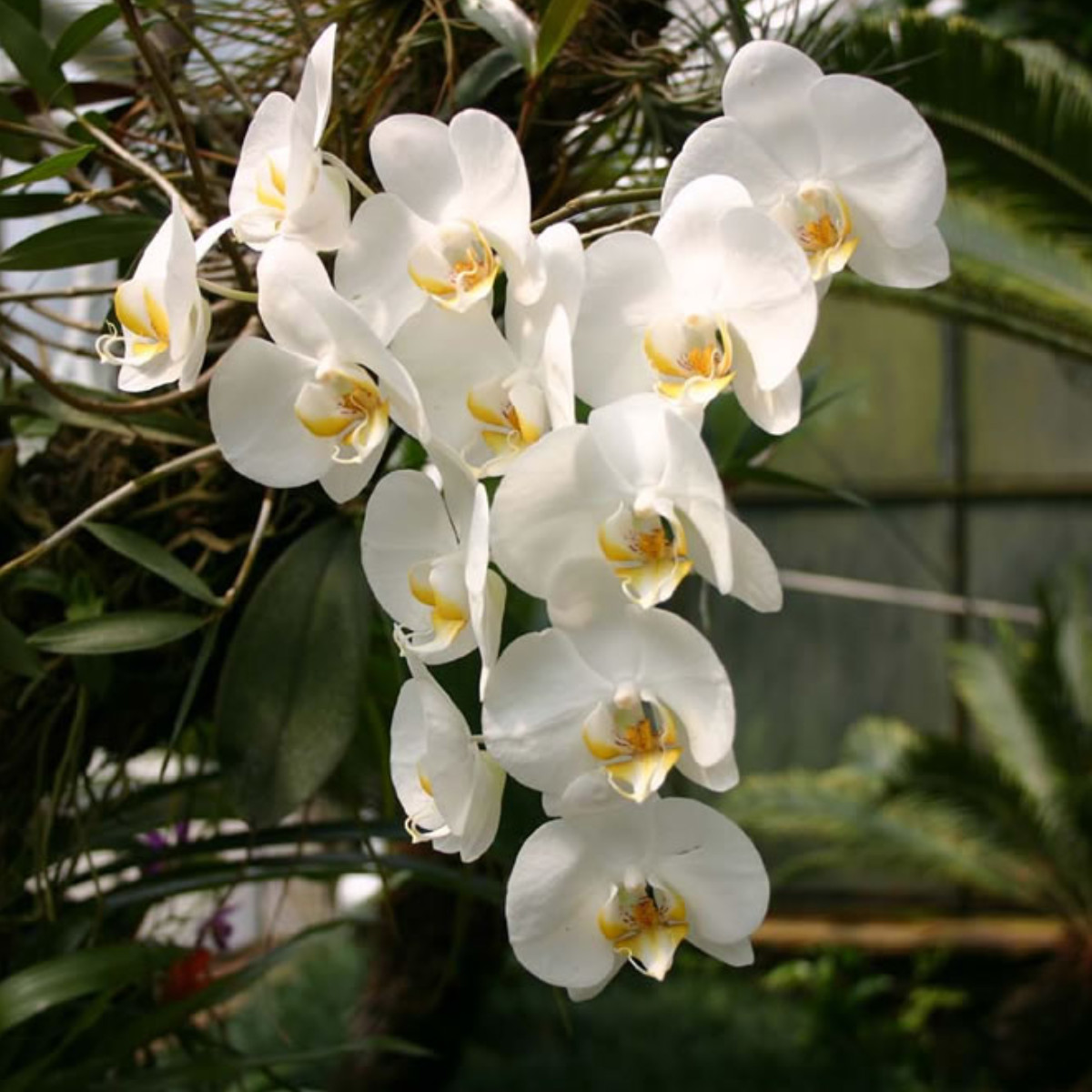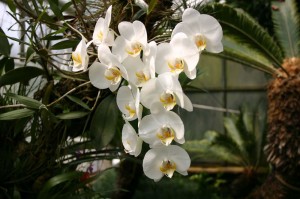Common name: Moth Orchid
Family: Orchidaceae
Synonymous: Epidendrum amabile
Cymbidium amabile
Synadena amabilis
Phalaenopsis grandiflora
Phalaenopsis gloriosa
Distribution and habitat: Phalaenopsis amabilis is native to Australia, Indonesia and the surrounding islands. Like other orchids, the Phalaenopsis amabilis is epiphytic, meaning it grows with air roots hanging onto trees instead of in soil. These epiphytes are growing high in trees either in dense forests or sometimes, close to the ocean.
Description: Phalaenopsis amabilis is an single stemmed epiphytes. The thick, upright stem up to 8cm (3 inch) tall carry wide, fleshy, alternate leaves which are limp. The leaves are up to 30cm (12 inch) long and 10cm (4 inch) wide dark green with reddish undersides.
Some aerial roots are produced on the stem among the lower leaves. Similar roots cover the potting mixture.
Arching flower stalk rise from the leaf axils can be 90cm (35 inch) long, with branches 30cm (12 inch) long. The flower stalk carry 20 to 30 flowers, each 10cm (4 inch) across. The pansy-like flowers in an inflorescence resembling a flight of moths are white, but the lip is spotted red with a yellow flush in the throat. Flowering occurs at any time and each flower lasts up to 3 weeks.
Houseplant care: Phalaenopsis amabilis is actually quite easy to grow and adaptable. To extend the flowering period, cut back flower stems after flowers fade to just below the point where the earliest flowers appeared. New blooms will appear on side-shoots growing from this point.
Light: Give Phalaenopsis amabilis bright filtered light throughout the year. During the short-day winter months some supplementary artificial light will encourage flowering.
Temperature: A minimum temperature of 20C (68F) throughout the year is essential, along with high humidity. Stand the plants on trays of moist pebbles and mist-spray daily. Proper humidity for this lovely orchid is around 50 to 80 percent.
By maintaining a temperature of 18-20C (64-68F) at night and 25C (77F) in the daytime for six - eight weeks, inflorescences will develop. In contrast, the inflorescence will not appear when the temperature is 20C (68F) or more at night. Thus, the flowers are observed mostly in winter.
Watering: Wilting caused by overly dry soil will set back the plants growth. Take care not to over-water the orchid, as it can develop root rot if its roots are left standing in water. Water the orchids moderately, allowing the top centimetre (0.4 inch) or so of the potting mixture to dry out between waterings. It is best to water in the morning.
Never permit beads of moisture to rest on Phalaenopsis amabilis leaves. These orchids are susceptible to rot and fungus infections and black spots will appear if the moisture remains on them throughout a single night.
Fertilising: Apply standard liquid fertiliser every two weeks or a foliar feed with every third or fourth watering.
Potting and repotting: Use osmunda, bark or peat-based mixture. For good drainage put a shallow layer of clay-pot segments in the bottom of the pot. These orchids do well in wooden or wire baskets lined with sphagnum moss. Every two years move plants into slightly larger containers.
After removing a plant from its container, clear the old potting mixture from the roots and cut away any dead roots before repotting the plant.
Plants growing in maximum-size pots should be replanted in fresh mixture once every two years. Immediately after repotting them, move the orchids into a shaded position for about three or four weeks. Repot at any time that plants are not in flower.
Propagation: Phalaenopsis amabilis can produce shoots at the base or in the joints of branches of flower stems after the season's flowers have died. Leave growths on the plant until their roots are at least 2cm (0.8 inch) or so long. They can then be carefully cut away and planted individually in 8cm (3 inch) pots of recommended potting mixture. Keep each potted cutting in a warm in bright filtered light and water sparingly for the first six weeks. Thereafter, treat it as a mature plant.
Problems: Failure for moth orchids to prosper in an indoor environment is most likely due to overwatering and insufficient light.
Under high humidity and inadequate ventilation leaves are more susceptible to brown rot or bacterial disease, which produces brown watery spots on the leaves. This type of disease often develops on young leaves in early summer (rainy season).
Treatment: An antibacterial agent is the only chemical that can effectively treat this disease.
Anthracnose blackens the leaf apex and blotchy spots are rarely observed.
Treatment: Fungicides are effective for this diseases. Spraying a chemical mixture of bactericide, fungicide and pesticide every one or two months is recommended in the wet season.
Flowers can develop botrytis cinerea in low temperature and high humidity conditions.
Uses: Phalaenopsis amabilis orchids have blooms that last for several months in the proper conditions. The orchid itself is very small but the flowers are relatively big and marvelous. With its beautiful flowers, this plant will surely enhance the beauty of the home and also purify the air inside the house. It said to remove VOCs (volatile organic compounds) and formaldahyde commonly off-gased from paints, solvents and other synthetic materials.
The stems make nice cutflowers for bouquets, or the individual flowers can be used as corsages. The vase life of Phalaenopsis amabilis last for 15-60 days.
SUMMARY:
CHARACTERISTICS:
Foliage green
Features - flowers
Shape upright
Height: 30-45cm (12-18 inch)
PROPER CARE:
Watering in active growth period moderately
Light bright filtered
Temperature in active growth period min 20C max 21C (68-70F)
Humidity high
Hardiness zone: 10-11
Begonia propagation f...
Essential Nutrients f...
Portulacaria afra
Tillandsia recurvata
Tillandsia stricta
Columnea microphylla
Clivia miniata
Cleyera japonica
Clerodendrum thomsoni...
Cleistocactus strausi...



